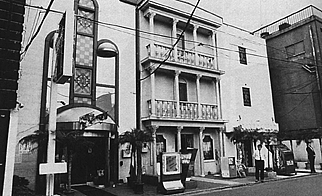|
On April 1, 1958 Japan's anti-prostitution law went into effect, but not without considerable opposition from the Tokyo Federation of Unions of Women Workers and brothel owners. The law forced brothels in the Yoshiwara to shut down or, as in most cases, transform their buildings into "toruko" (Turkish baths), what are now generically referred to throughout Japan as "soaplands." Typically of ornate europeanesque exteriors, soapland establishments offer men |
Yoshiwara as "Soapland," 1960s |
an expensive bath, massage, and usually a gradation of extra "services" performed by young women. In other words, soaplands are new-styled brothels--barely concealed as such--which are widely tolerated despite the anti-prostitution law. In a sense, one might see this tolerance as similar to the original pragmatic attitude of the Edo government to circumscribe to specific sites a business which is unlikely to be eliminated any time soon--in Japan or elsewhere. |
|
|
||
